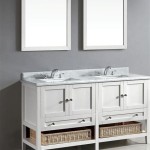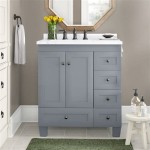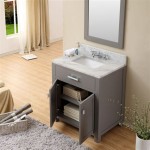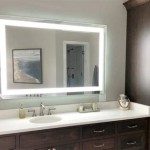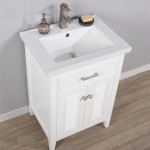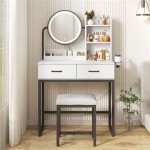35 Inch Bathroom Vanity With Sink: A Comprehensive Guide
The 35-inch bathroom vanity with sink represents a popular choice for homeowners seeking a balance between space optimization and functionality in their bathrooms. This size is particularly well-suited for smaller bathrooms, powder rooms, or remodels where maximizing floor area is a priority. The following article provides a detailed exploration of various aspects related to 35-inch bathroom vanities, including design considerations, material options, installation guidelines, and maintenance tips.
Choosing the correct vanity size is paramount in bathroom design. A vanity that is too large can overwhelm a small space, making it feel cramped and uncomfortable. Conversely, a vanity that is too small might not provide sufficient storage or counter space, rendering it impractical. The 35-inch vanity offers a middle ground, providing adequate functionality without sacrificing valuable floor space. It allows for a comfortable sink area and typically incorporates storage options such as drawers or cabinets, catering to the needs of a single user or a small household.
Beyond the size, the aesthetic appeal of the vanity is equally important. Vanities are often a focal point in the bathroom, contributing significantly to the overall style and ambiance. Therefore, careful consideration should be given to the design, finish, and hardware when selecting a 35-inch vanity with sink.
Design and Style Considerations
The design possibilities for 35-inch bathroom vanities are extensive, encompassing a wide range of styles to suit diverse aesthetic preferences. These styles can be broadly categorized into traditional, modern, transitional, and rustic designs. Each style offers unique characteristics that can complement the existing décor or serve as a foundation for a bathroom remodel.
Traditional vanities typically feature ornate details, such as raised panel doors, decorative moldings, and antique-inspired hardware. They often incorporate classic color palettes, such as warm wood tones, creams, and whites. These vanities evoke a sense of timeless elegance and sophistication, making them suitable for bathrooms with a classic or vintage aesthetic.
Modern vanities, on the other hand, are characterized by clean lines, minimalist designs, and a focus on functionality. They often feature sleek, handle-less doors and drawers, as well as contemporary materials such as glass, metal, and high-gloss finishes. Modern vanities are available in a range of colors, including neutral tones, bold accent colors, and metallic finishes. They are well-suited for bathrooms with a contemporary or minimalist style.
Transitional vanities blend elements of both traditional and modern styles, creating a versatile and balanced look. They often feature simple, yet elegant designs with clean lines and subtle detailing. Transitional vanities can incorporate a variety of materials and finishes, allowing for customization and personalization. They are a popular choice for homeowners who appreciate both classic and contemporary design elements.
Rustic vanities embrace natural materials and textures, such as distressed wood, reclaimed lumber, and stone accents. They often feature a weathered or aged finish, creating a warm and inviting atmosphere. Rustic vanities are well-suited for bathrooms with a farmhouse, country, or lodge-inspired style.
In addition to the overall style, the countertop material and sink type are important design considerations. Countertops can be made from a variety of materials, including granite, marble, quartz, solid surface, and laminate. Each material offers unique characteristics in terms of durability, maintenance, and aesthetics. Sinks can be undermount, drop-in, vessel, or integrated, each offering a different look and functionality.
Material Options and Durability
The materials used in the construction of a 35-inch bathroom vanity significantly impact its durability, longevity, and maintenance requirements. Several materials are commonly employed, each offering distinct advantages and disadvantages. Understanding the properties of these materials is crucial for making an informed decision.
Solid wood vanities are prized for their natural beauty, durability, and timeless appeal. Hardwoods such as oak, maple, and cherry are commonly used, offering exceptional strength and resistance to moisture. Solid wood vanities are typically more expensive than other options, but they can last for many years with proper care.
Plywood vanities offer a more affordable alternative to solid wood. Plywood is a composite material made from layers of wood veneer glued together, providing good strength and stability. Look for plywood vanities with a moisture-resistant finish to prevent warping or damage in the humid bathroom environment.
Medium-density fiberboard (MDF) vanities are another cost-effective option. MDF is an engineered wood product made from wood fibers mixed with resin and compressed into sheets. MDF is smooth and uniform, making it ideal for painting or laminating. However, MDF is more susceptible to moisture damage than solid wood or plywood, so it is important to choose a vanity with a waterproof finish.
The countertop material also plays a crucial role in the vanity's overall durability. Granite and quartz countertops are highly durable and resistant to scratches, stains, and heat. Marble countertops are elegant and luxurious, but they are more porous and susceptible to staining. Solid surface countertops are non-porous and easy to clean, but they may be more prone to scratching. Laminate countertops are the most affordable option, but they are less durable and may peel or chip over time.
The choice of hardware, such as knobs, pulls, and hinges, can also affect the vanity's longevity. Opt for high-quality hardware made from durable materials such as stainless steel or brass. Avoid inexpensive hardware that may rust or corrode in the humid bathroom environment.
Installation and Maintenance Guidelines
Proper installation and regular maintenance are essential for ensuring the longevity and optimal performance of a 35-inch bathroom vanity. DIY installation is possible with the right tools and experience, but professional installation is recommended for ensuring a safe and secure setup, especially when plumbing is involved.
Before beginning the installation process, it is important to carefully measure the available space and ensure that the vanity will fit properly. Check for any obstructions, such as pipes or electrical wiring, that may need to be relocated. Turn off the water supply to the bathroom before disconnecting the old vanity and plumbing fixtures.
Once the old vanity has been removed, prepare the floor by leveling it and cleaning it thoroughly. Install the new vanity according to the manufacturer's instructions, ensuring that it is securely fastened to the wall studs. Connect the plumbing fixtures, including the drain, water supply lines, and faucet. Check for leaks and make any necessary adjustments.
After installation, regular maintenance is crucial for preserving the vanity's appearance and preventing damage. Clean the vanity regularly with a mild soap and water solution. Avoid using abrasive cleaners or harsh chemicals that can damage the finish. Wipe up any spills immediately to prevent staining or water damage.
Inspect the plumbing fixtures periodically for leaks or corrosion. Tighten any loose connections and replace worn-out parts as needed. Avoid placing heavy objects on the countertop that could cause it to crack or break. If the vanity has drawers or cabinets, avoid overloading them, as this can strain the hardware and cause damage.
For solid wood vanities, consider applying a coat of furniture polish or wood sealant periodically to protect the wood from moisture and maintain its luster. For stone countertops, seal the surface regularly to prevent staining and etching. By following these installation and maintenance guidelines, homeowners can ensure that their 35-inch bathroom vanity remains functional and aesthetically pleasing for years to come.
Choosing the right 35-inch bathroom vanity with sink involves carefully considering various factors, including design, materials, installation, and maintenance. By understanding these aspects, homeowners can make an informed decision that aligns with their needs, budget, and design preferences.
The information presented aims to provide a comprehensive guide to 35-inch bathroom vanities with sinks, enabling readers to approach their bathroom renovation or upgrade project with confidence and knowledge.

Aoibox 35 5 In W X 17 7 D H Bathroom Vanity Cabinet Gray With Drawers White Ceramic Sink Top Snsa10in028 The Home

Home Decorators Collection Artisan 33 In W X 21 D 35 H Single Sink Freestanding Bath Vanity White With Black Marble Top Md V1758 The

35 Floating Bathroom Vanity With Sintered Stone Vessel Sink 2 Drawers Black Gray Homary

Vc Cucine 35 In W X 18 D 32 H Bathroom Vanity Gray With White Ceramic Top Hesebc047 Zc 90e 3 The Home

Free Shipping On 35 Modern Floating Bathroom Vanity Set With Single Sink White And Walnut Homary

Bellaterra Home 202424a S Wh 35 In Bathroom Vanity Set

35 Modern White Black Wall Mounted Bathroom Vanity With Integral Stone Sink China Melamine Cabinet Made In Com

Dwvo Bathroom Vanity With Sink 35 4in Freestanding Cabinet Glossy Storage Under Unit Black Wal Com

35 Floating Bathroom Vanity With Sintered Stone Vessel Sink 2 Drawers Black Gray Homary

James In 210 V36 Li 35 1 2 Bathroom Vanity Qualitybath Com
